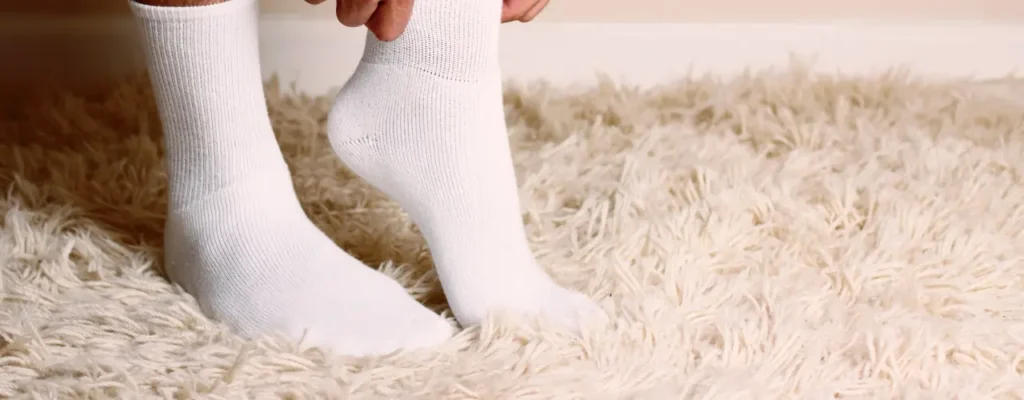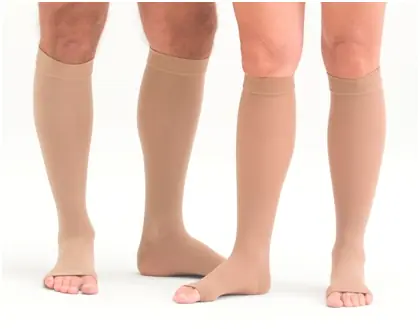When you’re dealing with diabetes, every little thing is a big deal.
It’s not just about being able to check your blood sugar—it’s about knowing how to help keep yourself healthy and happy.
You have to put in the work. You have to stay active and exercise regularly, eat right, and maintain good habits. But that’s not always easy when you’re dealing with diabetes.
You can feel like no matter what you do or how hard you try, it just doesn’t seem like it’s enough. And then there’s the fact that your body changes over time—you may experience some serious complications that could make living with diabetes even harder than it already is!
That’s why it’s so important for you to understand what compression socks vs diabetic socks are all about. If you’re looking for a new pair of socks and you need to choose between compression socks and diabetic socks, here are some things to consider.

Difference Between Diabetic and Compression Socks
The short answer is they’re both types of socks that help improve your circulation, but they do it in different ways.
Compression socks work by compressing your lower legs and feet to increase blood flow in your feet. This, in turn, can help reduce swelling and pain related to poor circulation. Compression socks can also help improve joint mobility and reduce muscle stiffness.
Diabetics wear diabetic socks if they have peripheral neuropathy (a nerve disease that causes numbness in the feet and legs as well as extreme sensitivity to cold) or other symptoms of poor circulation.
What makes them similar?
Diabetic Compression Socks

Diabetic compression socks are designed to help reduce the amount of blood flow to your feet, which can reduce swelling and pain. They’re also helpful in preventing ulcers from forming on your skin.
They may be used to prevent further damage to the skin around your big toes, which will help prevent further complications such as amputation or nerve damage.
If you have neuropathy (nerve damage), these socks will help reduce symptoms such as numbness and tingling sensations in those affected areas by providing extra support to damaged nerves while they heal over time.
However, females during pregnancy should wear compression socks for maternity as they have a chance to develop gestational diabetes.
How Do Compression Socks Work for Diabetics?
Are diabetic socks the same as compression socks?
Compression socks are not the same as diabetic socks. The two types of socks are designed to do different things, and they’re not interchangeable.

Diabetic compression socks are designed to help improve circulation and reduce swelling in your feet and legs by compressing the foot or lower leg against the ankle during movement.
They also can help prevent varicose veins with athletic activities like running or hiking (and even general activity).
Compression socks do not have this feature because they don’t compress anything beyond what compresses itself when you move around while wearing them. They just make it feel more comfortable by providing extra padding where needed most
Factors to maintain while wearing compression socks if you are diabetic
If you are diabetic, it is important to check with your doctor before using compression socks.
Some people with diabetes may be at risk of developing blood clots in their legs from the compression of wearing these socks. If this happens, they could cause serious problems, including amputation or death.
In addition, if you have diabetes and are wearing compression socks, it is important that you monitor your blood sugar levels regularly throughout the day so that you can ensure that your blood sugar remains stable.
If it starts to drop too low, call your doctor immediately. If you wear compression socks while sleeping or resting, it is important that you monitor your blood sugar levels regularly throughout the day so that you can ensure they remain stable.
If they start to drop too low, call your doctor immediately.
If you are still unsure and looking for a detailed information about choosing, read our Ultimate Guide and also see the Alternatives To Compression Socks.
Also Read Our Reviews:
FAQs – Get More Answers Here!
Neuropathy is a condition that causes pain and numbness in the feet, hands, and legs. It’s most common when you have diabetes, but it can also be caused by other diseases like Lyme disease or lupus.
For those who have diabetic neuropathy, it’s a must to know how compression socks treat neuropathy and how they are an important part of maintaining circulation and reducing swelling in the legs. They also help prevent nerve damage caused by prolonged pressure on nerves during daily activities like walking or standing for long periods of time.
The answer is yes.
Compression socks are designed to help treat health conditions such as circulatory problems, diabetes, and more. They can also be used to help prevent blood clots from forming, which is another benefit of compression socks.
Diabetes and circulatory problems are both conditions that can be treated with compression socks.
If you are diabetic, it is very important to wear compression socks with the right amount of compression.
The right amount of compression can be determined by measuring the circumference of your foot, which should be no more than 7 cm (2.8 in) smaller than your actual foot size. This means that if your foot measures 8 inches around, then the socks should have a circumference of 6 inches or less.
You can measure how much your foot is compressed by putting it into a sock and then pulling as tight as you can without cutting off circulation. If there are no marks left on the sole of your foot, then you have found the right amount for you.
Conclusion
In conclusion, compression socks are a great alternative to diabetic socks. They can be worn under your regular shoes and come in all sorts of styles and colors.
They work well for people with diabetes because they provide extra support around the ankle to help prevent blood pooling (and therefore causing a clot).
The only downside is that they cost more than regular socks, but if you’re looking for something that will make your feet feel better all over again then this could be worth it!


